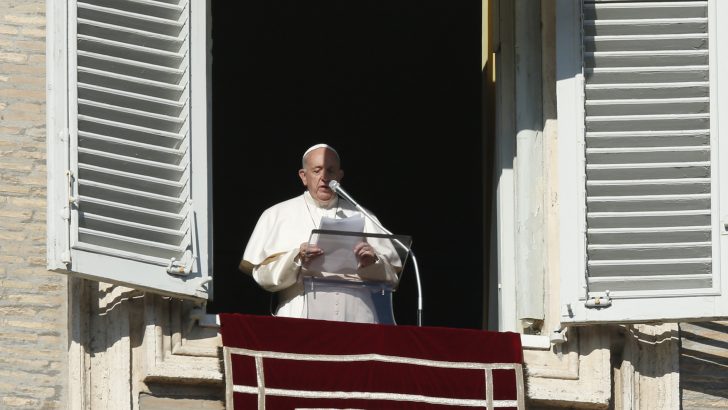If anyone has read a tabloid, they’ve probably seen the ‘they’re just like us’ section featuring favourite celebrities doing normal things like taking their kids to the park or walking around in jeans and a t-shirt with a Starbucks in hand.
One might think, for example, of the humanising photos of Kate Middleton, Duchess of Cambridge, shaking her finger at a sour-faced Prince George or a wiggly Princess Charlotte.
Pope Francis had his own ‘just like us’ moment in a two-part episode that began New Year’s Eve when an overly enthusiastic woman grabbed his hand and yanked him toward her, causing Francis to stumble and lose his cool, slapping her hand twice to release himself from her grip.
During his Angelus address on New Year’s Day, the Pope apologised for losing his patience, saying he was sorry “for the bad example yesterday”.
The reaction among ordinary people who typically don’t follow Vatican happenings was largely supportive of the Pope, however, Church-insiders predictably divided along ideological lines, with Francis enthusiasts saying the woman was out of line, and critics complaining over what they said was the use of “physical violence” tantamount to battering the woman.
Tugged
Italian politician Matteo Salvini, a known opponent of Francis’ welcoming stance on immigration, also weighed in, posting a video on Twitter of him being “tugged by an agitated fan”, presumably his wife, in which he first takes a “strike-pose” that looks like he’s going to slap her, but instead caresses her face.
However, looking back to even recent papal history shows that a Pope losing his cool has nothing to do with ideology, and is not limited to Francis.
St John Paul II, for example, was known to have a thick streak of Polish stubbornness and a quick temper, rarely holding anything back, even in public.
Perhaps the most memorable example of this aspect of John Paul’s personality is his 1983 public chastising of Nicaraguan Fr Ernesto Cardenal. Upon his arrival at the Managua airport for a visit to Nicaragua that year, John Paul, who could be seen waiving his finger, stopped to reprimand Cardenal as the priest knelt to welcome him.
Though he didn’t ask forgiveness, Francis has lost his patience in the past”
A year later John Paul suspended Cardenal from public ministry due to his political militancy and for joining the Sandinista government of Daniel Ortega, who openly sought to suppress the Catholic Church, as Minister of Culture. Francis lifted that suspension in February.
John Paul was also noticed for his coldness when, after arriving in the US in 1979, Sr Theresa Kane urged him to include women in “all ministries of our Church”, and in 1991 he shouted with a red face and shook his fist in the air while delivering a heated speech in Poland over the postponement of a bill that would have outlawed abortion in the country.
However, it was also John Paul II who normalised papal apologies, though never in his name, issuing hundreds throughout his pontificate, most memorably during a Mass in 2000 for a Day of Pardon, during which he asked forgiveness for sins committed against Jews, heretics, women, Gypsies and native peoples.
Benedict XVI personalised papal apologies when in a 2008 trip to Australia he issued an historic apology for child sexual abuse by priests in the country, assuring them that as their universal pastor, he shared in their pain.
Internet
He also made a personal apology in 2009 for lifting the excommunication of a bishop who denied the Holocaust, saying that had he consulted the internet, the situation could have been avoided.
Benedict was also no stranger to assaults from the crowd. On Christmas Eve Mass in 2009, for example, he was tackled by a woman who jumped the barricades and hurled herself toward him while he walked down the main aisle. Though in this case, slapping was hardly an option as he was still being helped off the floor when the woman was carted away by Vatican security.
***
Francis losing it with an overly aggressive pilgrim, then, is certainly not out of the realm of imagination for papal conduct, and neither is issuing an apology.
Though he didn’t ask forgiveness, Francis has lost his patience in the past. In a 2016 visit to Mexico he called a young person ‘selfish’ after the teen caused him to fall on top of a man in a wheelchair in an attempt to grab rosaries from his hand.
However, what Francis’ New Year’s incident seems to reveal is that people find his “humanity” appealing.
Several commenters on Twitter, for example, voiced support for the Pope’s apology, with one commenter saying “No one is perfect. Apology, forgiveness, and redemption are even better.”
Another comment said: “It must be freaky, having people grab at you like that,” adding that it’s “nice to see he’s human, and nice to see him demonstrate the ability to apologise. We could use more of that in this world.”
One takeaway from Francis’ episode then, could be that while some Popes are appreciated for their strength or meekness, Francis is often appreciated for his relatability, and his New Year’s back-to-back slap and apology can perhaps be seen as a clear example of that.
Elise Harris is Senior Correspondent of Cruxnow.com


 Pope Francis leads the Angelus from the window of his studio overlooking St. Peter's Square at the Vatican Jan. 1, 2020. (CNS photo/Paul Haring)
Pope Francis leads the Angelus from the window of his studio overlooking St. Peter's Square at the Vatican Jan. 1, 2020. (CNS photo/Paul Haring) 